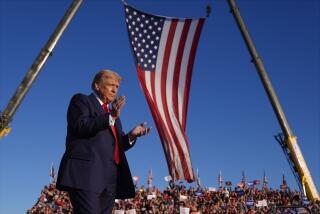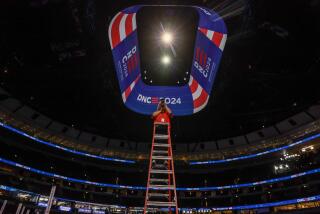In Philadelphia, It’s a Whole Other Story
- Share via
PHILADELPHIA — “I went to Philadelphia, but it was closed,” W.C. Fields once joked. It will be anything but this July when the city is host to the 19th Republican National Convention.
Philadelphia 2000, the convention’s local host committee, plans to spend $50 million and has rallied hundreds of organizations to sponsor more than 1,000 events and improvements for the July 31-Aug. 3 gathering. It also recruited 9,000 volunteers in less than a month. While the city is still looking for more workers, organizers say the number they’ve recruited so far is testimony to residents’ civic pride in the city’s first national convention in 52 years.
“What tipped Philadelphia over the edge for us was an intangible level of enthusiasm and excitement,” said Tim Fitzpatrick of the Republicans’ national site selection committee. The city’s bid was up against seven others, including those from Chicago, New York and New Orleans, the most competition the GOP has seen in recent years.
The entire city seems to be involved--from the Philadelphia College of Art, which plans to exhibit paintings made by elephants; the Please Touch Museum, where children can make powdered wigs, and the Philadelphia International Airport, which commissioned 100 elephant-shaped plant holders. Even the buildings that form the downtown skyline have agreed to change their exterior lights to red, white and blue for the four-day event.
Earlier this month, the Philadelphia Daily News reported that city workers were putting in 10-hour days to beautify some downtown intersections with new traffic signals and light posts bearing flags from the U.S. states and territories. In April, Mayor John Street ordered fleets of tow trucks to remove about 1,000 abandoned cars from city streets. And the city is postponing its traditional Fourth of July events, such as an appearance by the world-famous Mummers, so they will coincide with the convention.
Even nearby New Jersey is involved. That state’s Department of Transportation recently tore down two liquor stores and a bar along its side of the states’ shared border to create a welcoming open green space. (The outskirts of Philadelphia line the Pennsylvania side.)
*
Philadelphia’s last convention was the 1948 GOP gathering. As the years passed, Republicans and Democrats both required more and more meeting space, putting Philadelphia out of contention for a convention until the 22,000-seat First Union Center was completed in 1996. About 2,000 additional hotel rooms also were built recently but some of the 45,000 delegates, alternates and journalists still will be staying as far away as Wilmington, Del., a trip of at least half an hour.
As executive director of Philadelphia 2000, Karen Buchholz has an epic enthusiasm for the city.
“If people haven’t been here in 10 years, they really haven’t been here,” she said, repeating the Philadelphia Convention & Visitors Bureau slogan. The host committee is working closely with the bureau, which hopes a successful convention will prove the city has more tourist attractions than just the Liberty Bell and cheese steak sandwiches.
However, Chip DiPaula, the convention’s manager, said Philadelphia’s illustrious history as the site of the Constitutional Convention, the signing of the Declaration of Independence and the nation’s first capital was a boost for its convention bid and a plus for presidential candidate George W. Bush.
The setting “provides a great opportunity to reflect on our values of the past and our nominee’s vision for the future and those values that really created our nation,” DiPaula said.
The economic impact of a hosting a national convention is substantial. In an advance study of Chicago’s 1996 Democratic National Convention, the Federal Reserve Bank and University of Illinois projected the city would see an immediate impact of $125 million.
“Over the course of a decade, we’ll get billions of dollars,” said former Mayor Ed Rendell, who saw during his tenure what the 1993 Tom Hanks film, “Philadelphia,” did for the city. “The requests from European travel agencies increased tenfold.”
*
During his eight-year mayoralty, Rendell helped the city narrowly avoid bankruptcy and then went on to build a half-billion-dollar Avenue of the Arts and performing arts center downtown, where almost 100,000 people live. The development has spurred a restaurant boom, prompting Conde Nast to name Philadelphia the best per-capita restaurant city in the U.S. two years ago.
“We’ve gone from a sleepy old town whose only interesting thing was the Liberty Bell and Independence Hall, and we’ve materialized into a wonderfully exciting tourist destination,” he said.
Rendell, who left office at the turn of the year and now leads the Democratic National Committee, worked with current Pennsylvania Gov. Tom Ridge, a Republican, to capture the GOP convention.
The city and the state each allocated $7 million, and Ridge raised most of the remaining $36 million. He also has said state troopers will be available to escort delegates and dignitaries.
The city, for its part, has pledged 350 motor coaches, a free shuttle service that will run 18 hours a day and a “street concierge” staff to help visitors with directions and offer ideas on what to do.
Buchholz is hoping Philadelphia’s time in the global limelight will help it come out from under the twin shadows of New York and Washington, D.C., the nation’s first and 23rd largest cities respectively.
Philadelphia, with 1.4 million residents, is the country’s fifth most populous metropolitan area, but that status is threatened by San Diego and Phoenix. Each is rapidly growing in population, while Philadelphia’s has declined 10% in the last 10 years.
Still, Rendell feels Philadelphia is on the upswing.
“Once someone’s seen Philadelphia, it blows their mind compared to their image, which is why it was so important for us to get the convention,” he said. “We’re going to have [thousands of] people seeing the ‘New Philadelphia,’ and we couldn’t buy that type of exposure for a billion dollars.”
More to Read
Sign up for Essential California
The most important California stories and recommendations in your inbox every morning.
You may occasionally receive promotional content from the Los Angeles Times.













